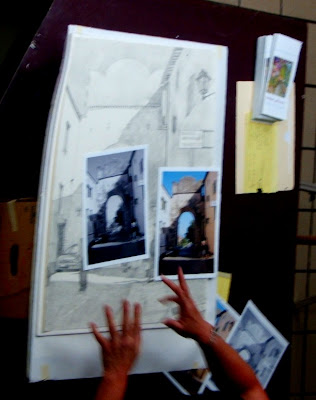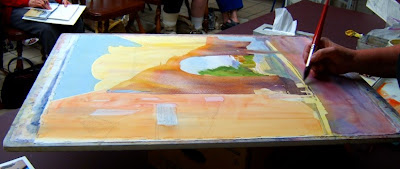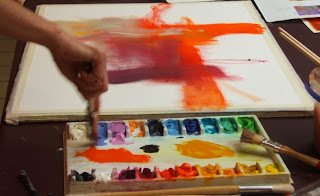Guest Speaker/Artist
Joan Miley (Programs) introduced our guest artist,
Judy Anderson. Judy’s program today was called “Working from Photographs: A Resource, Not a Religion.” She talked to us about using the photographs we take as guides to our final painting, but to realize that a single photograph does not always equal great art. She stressed that you “add your own orchestration” to the photo you take to compose it in the best way, making changes that will make a better painting.

Judy began by showing us how she uses a photograph for her final painting. She takes the photo to a copy shop and has it enlarged in black and white. She wants the black and white copy so she can make the colors of the painting hers, and not be a slave to the colors in the photo. Also, when she begins working on her painting, she is interested only in the main subject (the center of interest), not everything else around it in the photo. She stressed that you need “good bones” for a good painting so your foundation work - your photo, your black and white enlargement, your value study, and your compositional changes – are all creating a strong foundation to make a good painting.
Judy is famous for working with blocks of bold, bright color, whether she’s painting with pure watercolor or with gouache. She said she works with the five kinds of compositions:
1. vertical
2. horizontal
3. overall pattern (like a quilt pattern)
4. circular
5. cruciform
If she can take her basic subject matter and make it work in all five compositional elements, she knows she has a good painting. However, she suggested you start with just two or three shapes unless you want to give yourself a headache!
Judy’s motto is, “Think Twice, Paint Once.” She spends time creating a good composition from her photo before she ever puts paint to paper.

After the preliminary talk, Judy started the demo with a photograph taken in Italy of a building, and the enlarged black and white photo. Using a blue watercolor pencil, she drew the lines of the building on her watercolor paper, making changes as she drew. The watercolor pencil lines will wash off once she puts water on her paper. She didn’t want the painting to be all straight lines like the photo showed, so she curved some as she drew. She didn’t want so much blue sky showing in her painting, so she made another building behind the building in her photo reference, cutting into the sky. She was working with the shapes in the photo, not “a building with windows, doors, and a roof.” She said she wants to have “less photo, more Judy” in her paintings by making the photo more interesting and more fun. She believes it is her job to compose the painting and make it work for the viewer.
Judy began painting her finished sketch. If she puts down a cool color, she goes over it later to darken it with a cool color; if she puts down a warm color, she goes over that later with a warm color. If you mix cool and warm over each other, you get muddy color. She said she is constantly aware of the shapes throughout the painting, and she normally puts in her darks last.

Judy said it doesn’t matter what the color is, break it up so you don’t paint lots of solid color. Even in her blocks of color in this painting, she added orange to yellow and had three different blues in the sky. She prewet a block and put in color while the block was still wet. She used Arches hotpress 140# paper. She almost always uses hotpress paper for her work.
Judy uses a lot of colors, but suggested that the more difficulty you have with color, the fewer colors you should use until you are more comfortable. She always leaves white space around her painting in case she wants to add a design element in that space later.
When working with pure watercolor, you may need to put gouache over it in an area. If you do that, you have to repeat that gouache in several places in the painting so that one spot doesn’t look like you had to fix a mistake. Make it look like you planned to add it there!
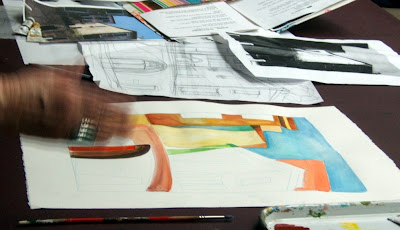
Judy didn’t like the way the door was looking in the painting so she added dots to the shape to change the look. She said dots or some pattern can take a boring area and make it more interesting, and you can tell from many of her paintings how much she loves patterns and textures.
When her colors butt up against one another, she makes sure to vary colors from cool to warm to cool, constantly varying the temperature of any colors right next to each other. This makes each color stand out more strongly. Her art inspirations come from Cezanne and some of Picasso’s work, and she mentioned how she loved Andrew Wyeth’s work because he really knew how to plan his shapes, even though he painted realistically.
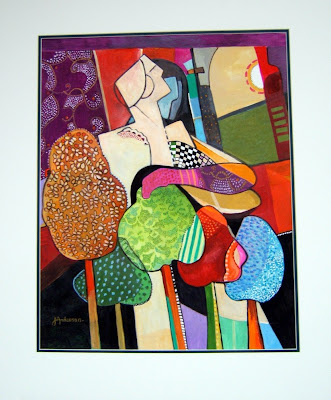
Judy had two finished paintings on the easel in the front of the room for us to view more closely. These paintings really showed off her bright, whimsical style. You can also see more of Judy’s
artwork at her website. Just go to
http://artbyanderson.com/ for more paintings and information about this warm, funny, talented lady.
Paint-Along Session
Judy not only gave us a very interesting and informative talk and demonstration today, she also agreed to stay after and share more about her techniques in the after program paint-along. Several of our artists took up the challenge and tried to learn more how to incorporate some of these techniques and compositional principles into their own paintings.
Critique Session
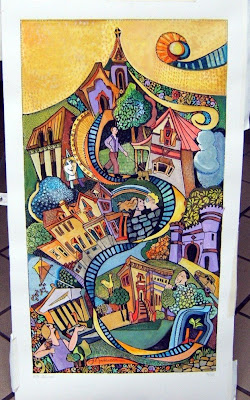
Judy led the critique session today. We had a large number of paintings up for critique, including watercolor florals, still lifes, a watercolor/collage piece, and an acrylic painting. As she critiqued the paintings, Judy talked about values and the need to change your values throughout your painting. She said we should not be afraid to put strong darks in our paintings. She also said it is important to change your colors – don’t just paint the same color green throughout in leaves or grasses, but vary those greens by touching in other colors to break up solid color
that can quickly become boring.
When Sam Hollingsworth shared his painting of four older men who seemed to be fading into the background, Judy talked about message paintings and how much she likes them. She said, as the artist, you are the entertainer and you tell the story. Sam’s story was about the way older men become invisible to the young. Judy said your message can be shared using color, design, or by your creative thought so you should work hard on the title of a message painting so the viewer gets it right away.
Administration Reports
Shirley welcomed us and gave a timely quote about photographs and painting from the Scottish artist, Peter Doig,
“I'm not trying to make paintings look like photos. I want to make paintings using photos as a reference, the way painters did when photography was first invented.”
Jane Hittinger (Membership) introduced our two guests: Audrey McKinney, from Hamilton, OH, is a Cincinnati Art Club Associate member who just started painting again after being away from it for a few years. Marilyn Zeh, from Cincinnati, said she was looking forward to learning more about us since this was her very first time at a GCWS meeting.
Alice Fossett (Treasurer) reported our current balance as $9,741. Dues are coming in, but some members still need to send a check to Alice for yearly dues. You cannot be in the Evergreen show if you haven’t paid your dues for 2009.
Evergreen Spring ShowDeb Ward reported on the progress of the Evergreen Show (April 26 – May 31). We still need people to sign up for sitting the show or giving demos on the weekends. All information on the show and the registration forms were mailed to all current members so everyone should have received that in their mailboxes.
Postcards were distributed today, and Deb asked members to take as many as they needed. Although our theme this year is “Seven Year Itch,” you do not have to have seven things or incorporate the number seven in your painting in order to be in the show. You must drop off and pick up your paintings for the show or ask a friend to do it for you if you are going to be unavailable (April 23 drop off and June 1 pick up). The Evergreen staff will not hold your paintings for you if they are not picked up; they will be taken to Deb’s home in Indiana and you will be responsible for picking them up there.
Sharon Roeder sent out publicity on the show. The information is also on our blog. Sharon has hard copies she will mail to you if you need them. After the
John Ruthven lecture on May 1, she will revise the publicity handouts to give more information on Sam Hollingsworth’s demo. Sam is asking for “good-will donations” to be paid for the demo and will donate those to the scholarship fund. We appreciate Sam’s generosity!
Springtime Art ShowsColerain Artists are having their “Expressions of Spring” show at the Farbach Werner Nature Preserve, 3455 Poole Road, Cincinnati. The show can be viewed on April 18 (10-4) and April 19 (12-4).
Queen City Art Club has their “Spring on Main Street” show at Chesterwood Village, 8037 Tylersville Road, West Chester. The show opens with an artist reception on Sunday, April 19 from 2-4 and runs through May 15. The show is open daily from 8 am to 6 pm.
Stephen Blackburn is coming to Cincinnati May 15-16 to give a workshop on his pouring technique. Contact Deb Ward for more information.
The Southeastern Indiana Art Guild’s spring show will be running April 25-May 2 in Aurora, Indiana. Contact Mary Moore for more information about the show.
Howard Krauss noted that there are still a few spots open for the Tom Lynch workshop in June. The price, only $450 for the 4-day workshop, is a real bargain in price as Mr. Lynch’s workshops usually cost much more. Contact Howard if you are interested and need more information.
The Brushettes Art Show at the Women’s Art Club Gallery in Mariemont will begin with an artist reception Friday, April 3. The Exhibit will run April 4-26 and can be seen Saturdays and Sundays only from 2 to 5 pm.
Scholarship
Bonnie Rupe reported that she and the scholarship committee will visit Winton Woods High School on April 22 to view/choose art for the 2009 scholarship award.
DVD LibraryMarilyn Bishop announced that the Tom Lynch DVD is damaged so we have to take that off our library list. Remember, if you sign out a DVD, please return it the following month so other members have a chance to see these programs.
Next Program/Guest ArtistBarb Smucker, local artist, will give our May program and demonstration.
Special NoticeShirley read an email from Barb Pryor that informed us of Mary Marxen’s injury and health issues. A card was passed around to sign and mail to Mary to cheer her. She has been through several health issues lately and we all wish her a quick recovery and safe return to our meeting in May or June! If you’d like to send Mary a personal card or note, her Florida address is in the membership directory.

If you know which two paintings you are going to put in the upcoming Evergreen show, please email Deb Ward with that information so she can begin on the name/title tags early. Here’s a photo of the postcard for the show, containing the artwork of Tamara Scantland Adams (lemons) and Joyce Friedeman (boat). Congratulations, Tamara and Joyce!

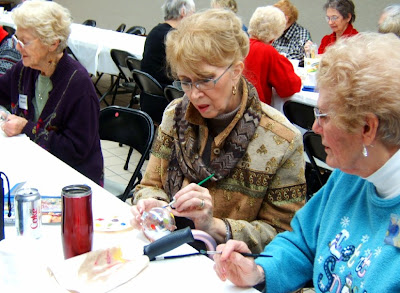 After everyone had a chance to paint one or two glass pieces, we had our holiday luncheon. Our thanks go to Joan Miley, who prepared and presented the meal. I heard many people saying how delicious it was, and I think some went back for seconds. J
After everyone had a chance to paint one or two glass pieces, we had our holiday luncheon. Our thanks go to Joan Miley, who prepared and presented the meal. I heard many people saying how delicious it was, and I think some went back for seconds. J




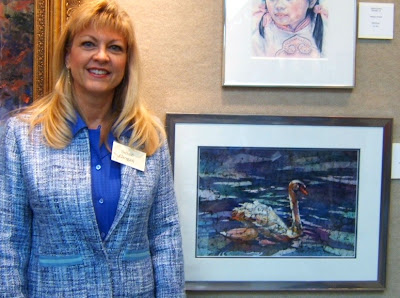
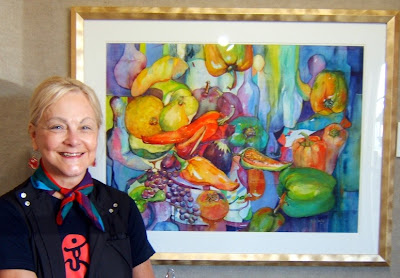

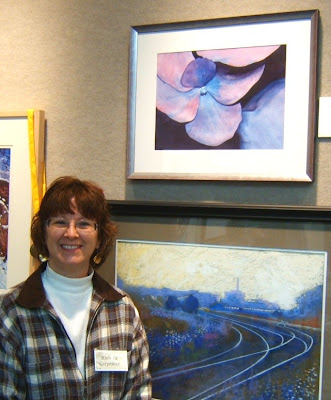





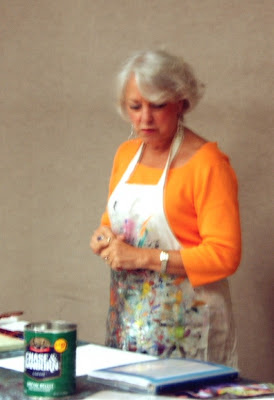 Critique Session
Critique Session









